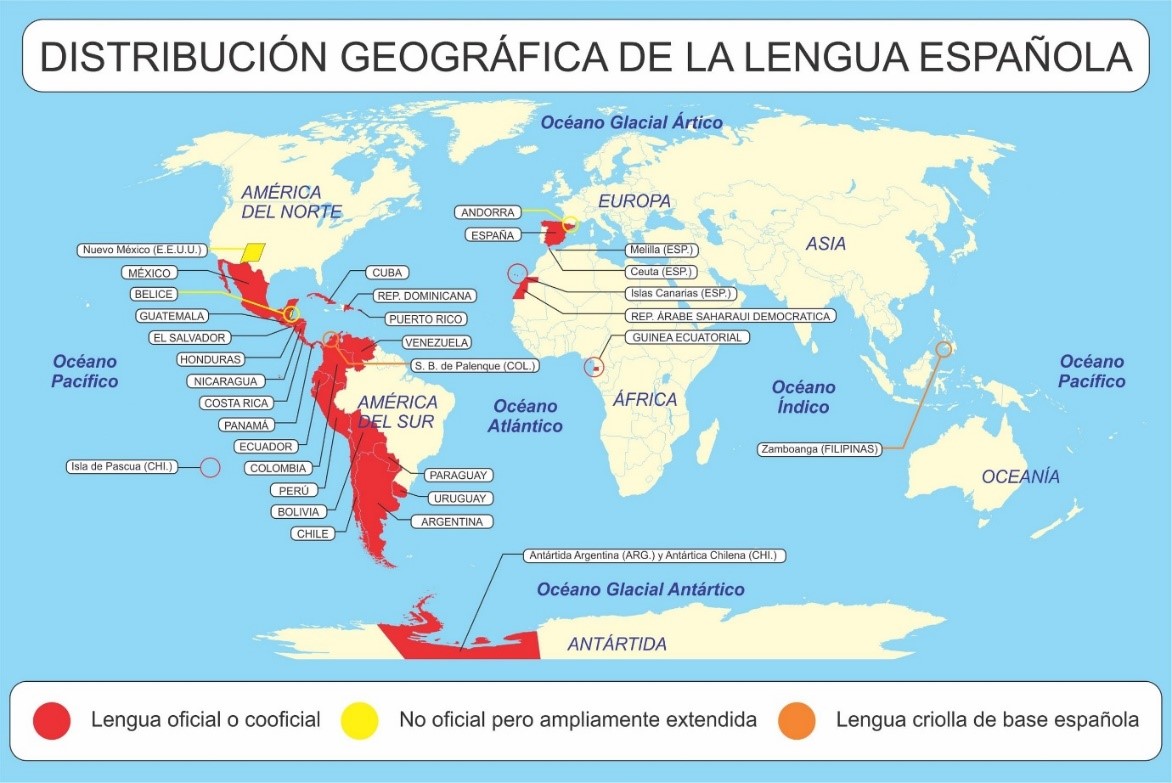Spanish is the official language in 21 countries around the world. Spain, of course is one of them. In the Americas alone, 19 different countries speak it. It is also the official language of Ecuatorial Guinea in Africa, which might come as a surprise to many. What comes as no surprise, when knowing this though, is that it’s no doubt one of the most spoken languages in the world and with it comes a huge amount of different Spanish Dialects.
Here’s a quick look at the Geographical Distribution of the Spanish Language:


This picture is a clear explanation of how vast the territory of Spanish speakers around the world is. There is an innumerable amount of different types of Spanish. Some call them varieties, but they really are linguistic differences that change from one country to another where Spanish is spoken.
If you thought the English language was complicated because of British English, American English, New Zealand English, South African English and Australian English – think again. When it comes to Spanish translation, the numbers and varieties are much higher.
The difference between language, dialect and accent
To dig deeper and understand better, we need to understand the difference between language, dialect and accent.
Many linguists try to avoid discussing the topic, as some people might take their definition as offensive or degrading towards the way they speak. Sometimes, dialects and accents are deemed as ‘improper speech’, so linguists often go with the word ‘variety’ instead.
In a nutshell:
Language is the official spoken and written language of a country
Dialect is a subset of the language with changes in vocabulary and grammar
Accent is part of a dialect, with an emphasis on how a group of people pronounces words
Therefore, as an example: English is a language, American is a dialect but someone from New York has a different accent than someone from Alabama.
In mainland Spain alone, there are distinct language groups:
- Catalan (Catalán-Valenciano-Balear) is spoken in Cataluña, Valencia, Andorra and the Balearic islands – Mallorca, Ibiza and Menorca.
- Basque (Euskera) is the language of an autonomous Spanish community in the Basque Region as well as in Navarra.
- Galician, highly influenced by Portuguese due to its geographical proximity is spoken in the Northwestern region of Spain.
These are all co-official languages to Castellano, which is the official language around the whole of Spain and which is what we all refer to when we say Spanish. It is, no doubt, the “official” language in all the 21 countries. However, due to the vastness of how widespread the language is around the globe, there are numerous different Spanish accents and dialects.
Here’s a quick example of two of the most popular languages and their differences in Spain:
Catalan vs Spanish
The difference between Catalan and Spanish is significant. Not only because they are officially, two separate languages but also because Catalan, in some ways is closer to French and Italian than it is to ‘Spanish Castellano’ itself.
You are currently viewing a placeholder content from Youtube. To access the actual content, click the button below. Please note that doing so will share data with third-party providers.
The Catalan Language
How many dialects of Spanish are there?
Really and truly, one can never know exactly how many dialects there are. In Latin America alone there are 12 main dialects. However this multiplies itself as some people who would be considered to fall under the same official dialect, such as Mexican, for example, will have subsequent dialects that differ from other people in the same country. A person from the North, does not speak the same as a Mexican from the South. In the same way, different villages, towns and cities in the South, have different dialects that distinguish them.
In a very reduced way, here are the two main ones – Spanish Dialects in Spain and Spanish Dialects in Latin America:
Spanish dialects in Spain
Andalusian – The Andalusian Spanish dialect has in itself two branches, the main one and the eastern one. This is probably the softest of all Spanish dialects and is spoken in the South of the peninsula.
You are currently viewing a placeholder content from Youtube. To access the actual content, click the button below. Please note that doing so will share data with third-party providers.
The Sound of the Andalusian Spanish dialect
In other regions of the peninsula however you will find other Spanish Dialects – namely
Extremenian
Canarian
Manchego
Madrileño
Murcian
Castillian itself then has its own variants –
Castellano aragonés, not to be confused with the Aragonese language. But also, Castellano riojano, Castellano churro and Castellano leonés.
Let’s also not forget Llanito – Spoken in Gibraltar, a British overseas territory, this is perhaps the very true example of ‘Spanglish’ because it combines Andalusian Spanish with British English.

Spanish Dialects in Latin America
Let’s now have a look at the 12 main Latin American Dialects:
Andean – Spoken in the mountainous Andes region in Perú, Bolivia, Ecuador, South East of de Colombia, North of Argentina and North of Chile. It is based in the Castillian dialect but also has indigenous elements in it in the more rural areas.
Carribean Spanish – Spoken in Antillas, Cuba, Puerto Rico, República Dominicana, Panamá, Venezuela, Colombian Caribbean, and some coastal regions in México. The Caribbean Spanish dialect is one of the fastest dialects there is, with major similarities to the Andalusian dialect. In various modern Latin American music, especially the infamous reggaeton, there is a huge number of Puerto Rican Spanish dialect.
Central American – Spoken in Costa Rica, Nicaragua, Guatemala, El Salvador, Honduras and Southwest of Mexico (Chiapas y Tabasco). Influenced by a cocktail of the Caribbean and Andalusian dialects mentioned above.
Rioplatense** – Spoken in Argentina, Uruguay, and in bordering regions like Patagonia chilena and Paraguay. See more details below.
Mexican*** – Spoken in Mexico, but also influences Central America and the South of the USA.
Chilean – Spoken in Chile, and part of the Cuyo region in Argentina. Influenced by the Andalusian dialect as well as the Extremadura one with an equal influence in different indigenous villages – such as quechuas and mapuches.
Paraguayan – Spoken in Paraguay, this dialect has a strong influence from guaraní and its neighbouring countries, Brazil and Argentina.
Central Colombian – Spoken in the inland regions of Colombia, differing between them in influences by of Spanish Dialects of the Spain of the old continent – Castillian, Andalusian and Extremadureño.
Ribereño – Spanish Spoken specifically in the coastal area of Peru.
Ecuatorial – Spoken in the Pacific Coast of Colombia and the coast in Ecuador. This dialect in specific has a strong African influence due to the high concentration of Afro-descendants in the population of this region.
Llanero – Spoken in the Llanos región in Colombia and Venezuela. It has a certain musicality to it due to the mix of indigenous and Andalusian influences.
Amazonian – Spoken in Amazonic regions of Colombia, Peru, Venezuela, Bolivia and sporadically in Brazil. Though it might sound farfetched, the dialects in this region are even more varied than in other places. These areas are considered ‘selva’ (the closest word to it in English is ‘jungle’). In these areas the local dialects vary with a strong influence from an innumerable amount of local dialects which are in turn, influenced by the many native languages and occasionally Portuguese.
This is just an overview of the most popular of Spanish dialects in Latin America. To understand the diversity better, let’s have a more in-depth look at two of them.
**Rioplatense
This dialect gets its name from the river Río de la Plata which borders the two countries that use it – Argentina and Uruguay. In the 20th century both countries saw a huge influx of Italian immigrants hence the strong influence of Italian on this specific dialect. At first it was due to poverty, when land was split in between too many siblings and therefore heirs. Later on, it was due to political and economic problems resulting from Fascism and eventually organised crime played its role in the economic difficulties to Southern Italians. As a result, in this region people will say “chau“ for goodbye, which is pronounced exactly like the Italian “ciao”.
Perhaps, the most distinguished characteristic of this dialect is that the double ‘ll’ and the ‘y’ are both pronounced as ‘sh’.
So if in Castilian Spanish we say, “Perdí mis llaves en la lluvia.” (I lost my keys in the rain.) In the Rioplatense dialect, you will hear, “Perdí mis shaves en la shuvia?”
Another main particularity about this dialect, is the swapping of tú for vos, which happens also in the Mexican dialect which we are about to talk about. This distinction has a huge effect, because it also changes the way you conjugate the verbs that go with them. Here’s an example: “Tú vives.” turns into “Vos vivÍs.”.
You are currently viewing a placeholder content from Youtube. To access the actual content, click the button below. Please note that doing so will share data with third-party providers.
The Argentine Accent
Get how much it varies? And that is just one of the many, many Spanish dialects.
Difference between Spanish and Mexican***
***The difference between Spanish and Mexican is one of the best examples of diversity in Hispanic people. Not only does the Spanish dialect in Mexico differ from the Castillian dialect which is mainly considered the generic Spanish, understood by all Hispanic people but Mexicans themselves distinguish themselves as speaking differently depending if they’re from the North of the country, or from the more centric and southern regions in the 32 different states across the country.
Fun fact: Did you know Mexico is officially named United States of Mexico?
Not only are there Spanish dialects in Mexico but various indigenous languages are accepted at national level, also as Mexican Spanish.
Náhuatl, being the indigenous language spoken by the biggest numbers of people, is considered an official language together with Spanish. However, this is just one of the 68 recognized original languages in Mexico together with what linguists have counted as 364 linguistic variants.
What Spanish dialect is taught in schools?
It all varies depending on where the school is. In Barcelona, for example, children are thought both the Catalan language as well as Castilian Spanish. In Mexico, students learn Spanish that varies from that thought in Madrid.
A clear example of this is the use of ‘vosotros’ in Spain, which could be translated into ‘you guys’ in English. In Latin America, this word is not used and with it, the verb conjugation disappears as well. ‘Ustedes’ is used instead, referring to the polite form of the 3rd person plural, ‘they’. Hence students in Spain, Europe learn 6 conjugations to a verb, while those in the Americas, only have to learn 5.
Latin American Spanish
When we say Latin America, it just seems like one big space where everyone speaks the same language right? Wrong.
As mentioned before, there are 19 Countries in Latin America that speak Spanish. There’s Central America, South America but also North America. (Yes, Mexicans are North Americans.)
19 countries – 650 million people. A whole lot of people. Of course, where there is a lot of people there’s a lot of differences. Even in the daily mundane stuff.
Let’s take a simple example to portray this: the word ‘avocado’.
Someone who speaks Spanish in Peru or Argentina, would call it ‘Palta’, in Colombia and Mexico, ‘Aguacate’, in Cuba, ‘Pagua’ and in Venezuela ‘Cura’.
Hence, even though they are all native speakers, they might not understand we’re talking about avocado if we use the word they’re not used to hearing.
Difference between Hispanic and Spanish
If that weren’t enough, there’s a whole lot of difference also between Hispanic, which is the Spanish spoken in Latin America, and Spanish, the “original”, “clean” version used in Spain, which was exported to the Americas during the time of the colonization.
Which dialect of Spanish is best to learn?
When it comes to learning or using Spanish in different areas, such as Tourism and Marketing translations – there is no best option of Spanish Dialects. The answer simply boils down to where you are going to use it.
Particularly in the field of Translations, it is of immense importance to have the detail down to the specific differences between Spanish-speaking countries. See avocado example above and this video:
You are currently viewing a placeholder content from Youtube. To access the actual content, click the button below. Please note that doing so will share data with third-party providers.
Differences Between Spanish In different countries in Latin America And Spain.
Hence, a lot of Marketing material could be literally, excuse the cliché, lost in translation. A pity to lose customers over such details after all the hard work of audience targeting.
Which of the different Spanish dialects shall I pick for translations?
It is highly recommended that when looking for Marketing translation services, you opt for professional translation services with qualified translators, who can assist you with multilingual seo services because even though all of the 21 countries all speak the same language, they might not understand what is written unless you use wording they’re familiar with.
Conclusion
If what you’re looking for is website translation services, do your research. You’ll most likely find EHLION to be a very competitive option when it comes to Spanish dialects, with translators from every region in the Hispanic world. Whatever you do – stay away from machine translation because it absolutely fails when it comes to country-specific differences.
Contact us at EHLION for a free quote on Spanish translations












